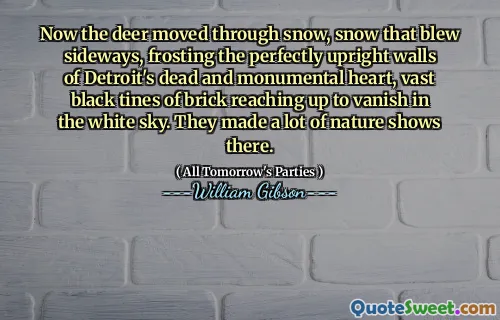
Now the deer moved through snow, snow that blew sideways, frosting the perfectly upright walls of Detroit's dead and monumental heart, vast black tines of brick reaching up to vanish in the white sky. They made a lot of nature shows there.
This excerpt from William Gibson's '(All Tomorrow's Parties)' paints a vivid and haunting image of Detroit, blending natural elements with man-made structures. The imagery of the deer navigating the snow amidst the stark, towering brick walls evokes a sense of resilience and adaptation in an environment that seems both abandoned and alive. The snow blowing sideways adds to the feeling of harshness and brutality of the winter, while the description of the brick walls as 'frosted' suggests a temporary beauty intertwined with decay. The 'perfectly upright walls' symbolize human achievement and permanence, yet their designation as part of Detroit's 'dead and monumental heart' hints at decline or desolation, perhaps alluding to Detroit’s economic struggles and urban decay. Gibson's brevity in noting that 'they made a lot of nature shows there' introduces a layer of irony; nature persists even in places marked by human decline, and perhaps emphasizes the contrast or coexistence of natural and urban landscapes. Overall, this passage compels reflection on themes of decay, endurance, and the cyclical nature of environments—where 도시의 폐허도 자연의 일부이고, 결국 자연이 우세한 상태로 돌아간다는 것. The imagery suggests that life persists and adapts in unexpected ways, even amidst desolation, and that there is an inherent beauty within the stark, frozen tableau of a once-thriving industrial heart. Gibson’s vivid, poetic description makes one ponder the relationship between urban decay and the persistence of natural life and how such scenes serve as a commentary on resilience and transformation.






